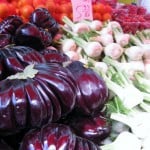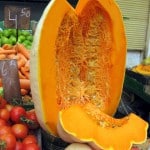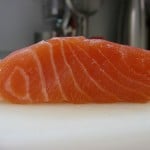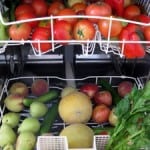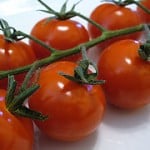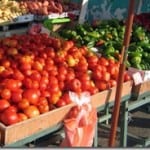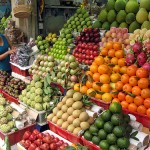It’s time for a review of posts you might have missed on Cooking Manager. Summer Cooking Healthy and Easy Summer Salads. Leora posted even more summer salad ideas. Some Like It Cold: Summer Soups Cool Summer Cooking Tips Prepare Vegetable Salads in Advance Recipes: Beets Marinated with Ginger and Garlic Wilted Red Peppers with Garlic […]
Ten Quick Tips for Cutting Your Produce Bill
The extreme heat in my part of the world has led to high prices in the markets, especially for vegetables. Here are some tips to help you cut down on your produce bill no matter where you live: Buy vegetables in season. Instead of buying according to your recipe, choose your menu according to the […]
Pan-Steamed Fish with Vegetables
Wednesday is Recipe Day at Cooking Manager. This technique works with almost any kind of fish: fillets or whole fish, salmon or whitefish. I וsed some tilapia fillets my husband had bought a few weeks ago on sale. I love to make fish this way because I don’t have to turn on the oven. I […]
A Tomato Surprise
Whenever you prepare fruits and vegetables, it’s important to check the outside for holes and blemishes. Sometimes a large, angry-looking discoloration can be just on the surface and cut off with the peel. It usually means that the fruit was scratched or scraped somewhere along the way. But other times, an insect or worm can […]
Tip: Use Your Dishwasher to Wash Produce
Washing vegetables under the faucet uses up a lot of water, even if you are efficient (keeping the faucet off when needed, and rinsing large amounts all at once). Long ago I considered washing produce in the dishwasher, but I didn’t actually try it until reading about it in unplgged. You can see from the […]
Twelve Tips for Getting More Vitamins from Your Food
Cooking at home is the best way to make sure that your food is high in quality and nutrition. Just by cutting out extra salt, fat and sugar and preservatives in processed foods, you’re ahead of the game. But all home cooking isn’t equal. Some techniques preserve the vitamins and minerals in your food, while others destroy them.
It’s not always practical to follow every technique each time. But the tips below can help you make better decisions.
1. Wash vegetables shortly before cooking or eating, and avoid soaking.
Ten Kid-Friendly Foods Using Leftovers
You’re a good cook when you can make a delicious dish from fresh ingredients. But creating something new based on leftovers is especially satisfying. Those of us who value frugality and conservation are proudest when our unique leftover-inspired creation are enjoyed by everyone in the family.
Every home cook has to manage leftovers one way or another. Serving leftovers as they are is the easiest and often the tastiest. But when they aren’t enough for a whole meal, or you suspect there won’t be takers, leftovers can enhance your next cooking project.
Never try to recycle food that is starting to spoil. Spoiled food cannot be salvaged. You will ruin the entire dish and risk getting everyone sick. Always examine food carefully, and heat leftovers thoroughly before serving.
Need help with organizing your leftovers? See Thirteen Smart Ways to Manage Your Leftovers
Follow the links for more detailed recipes.
Tips for Choosing Fresh Fruits and Vegetables
This is the third part of a series on shopping for fresh fruits and vegetables.
When you buy produce, you want the most for your money. But fruits and vegetables don’t come with an expiration date. I’ve collected these tips for helping you choose the freshest fruits and vegetables. Please share your tips in the comments.
Fruits and vegetables have seasons and you can’t always find the quality you want. Be flexible.
Always examine fruits and vegetables for blemishes, especially holes where insects may have entered. Many surface blemishes don’t affect the produce. But a soft spot will spread quickly to the rest of the fruit.
Produce, unless it is not ripe yet, should give off a fresh smell.
I’ve divided the produce into two categories: 1) Produce that starts going downhill from the moment it’s picked and 2) Fruits (mainly) and vegetables that can ripen or improve after you buy them.
Ten Questions to Ask When Buying Produce
This is Part II of a series on shopping for produce.
See Part I: Ten Questions to Ask Before Going to the Store.
Okay, you’ve assessed your supply and your future needs. You have a list and a plan. But it’s best to be flexible. Produce shopping is not an exact science.
Here are some questions to ask yourself as you walk through the market or the produce aisles in the grocery store.
1. Where did this food come from? For example, does it have a high level of pesticides? Is it grown locally, which saves on energy costs and pollution?
2. How ripe is it? You want a balance between produce that is ready to eat or will keep longer.
Save Time and Money by Washing Fewer Dishes
Whether or not you own a dishwasher, cutting back on the amount of utensils you cook with can save you time and money. If you rely on disposable, some of these will work for you too.
Adopt these tips to wash fewer dishes:
1. Have the whole family eat with their fingers straight out of the pot. (Okay, that was a joke. Did I have you going there for a minute?)
